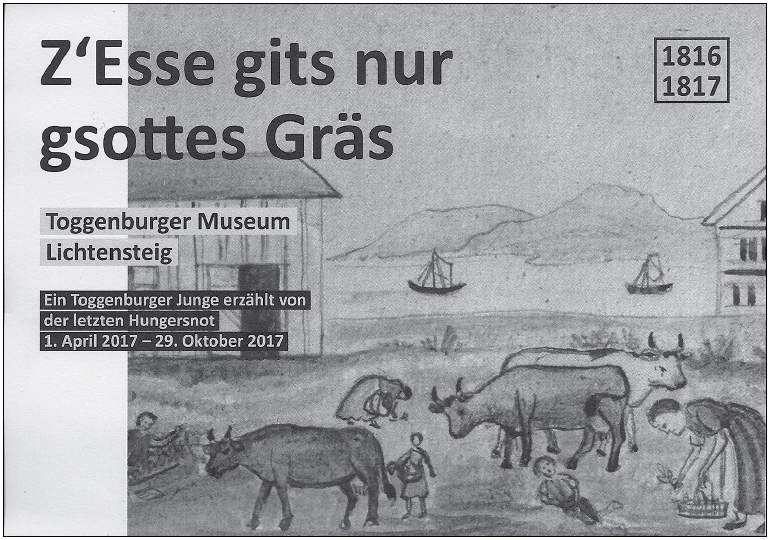Memories of the famine of 1816/1817 – Exhibition in the Toggenburg Museum in Lichtensteig
Memories of the famine of 1816/1817 – Exhibition in the Toggenburg Museum in Lichtensteig
Federal referendum on Food security of 24 September 2017
by Rita Brügger
In the context of the vote on the counterproposal on food security, which will take place on 24 September (see Current Concerns No 19), it is worthwhile contemplating giving some thoughts to it. The following exhibition may also give some inspiration.

Z’Esse gits nur gsottes Gräs (There is only boiled grass to eat)
Until 29 October 2017, the Toggenburg Museum in Lichtensteig, in addition to its permanent exhibition, presents a special exhibition on the great famine that raged in Switzerland 200 years ago. The strong explosion in connection with the eruption of the Tambora volcano in distant Indonesia caused huge precipitations of volcanic ash, which resulted in a strong climate change. This also had a lasting influence on the weather in Europe. The year 1816 became a “year without summer” and this resulted in the last great famine in Switzerland, which is impressively documented in the exhibition mentioned above.
The Toggenburg was particularly affected for various reasons. During this time of early industrialisation, the cotton industry was growing. The woven cotton cloths could be sold at a high price and, in return, cheaper grain could be purchased from southern Germany. But other countries were also affected by the famine. Therefore, no cotton was supplied to the textile workers, and thus there was no income. Without land, they were not autonomous and could not afford to pay the overpriced food. But the peasants also suffered from crop failure. The weather was not as usual. It was cold, and even in summer there were snowfalls. Besides bad harvests, the heavy rainfall also caused landslides in the hilly landscape, so that entire property was flooded or washed away.
Those who were familiar with botany and herbalism looked for dandelions and nettles in nature to feed themselves. Even small animals such as snails were eaten. But in their misery the people even grazed like cattle in the meadows to satisfy their hunger. Grass and hay were prepared appropriately to make it edible. There were also some people who gulped down what they had found uncooked. Thus the mortality in these two hunger years was extraordinarily high. In the exhibition, texts and pictures document this dying. Therefore, the Grim Reaper is depicted, waiting to pick up the weakened people, or a long funeral procession with several coffins depicts the number of inhabitants of a village who have died at the same time.
The people who could have a soup from their community were particularly fortunate. Impressively, the exhibition around a long table documents the history of the Toggenburg boy Ruedeli, who survived the time of the famine. The hollows in the table from which the poor people ate instead of plates, contain sequences of his history with suiting requisites. Thus the visitor of the museum walks around the table, lifts the covers to read and to understand that time.
After the two hunger years, it was a matter of concern for the survivors to document the experiences and the dreads of that time. Images and texts both were created in order not to forget what had been happening, and to remind themselves, that it could be worse at any time, but also with gratitude that afterwards there had been better times again. Thus the so-called hunger-plaques, as a memorial of the time of the great famine, were created.
The exhibition “There is only boiled grass to eat” will can be visited until 29 October in the Toggenburg Museum in Lichtensteig. The museum is open on Saturdays and Sundays from 1 pm to 5 pm. Guided tours take place on Sunday, 24 September and Sunday, 29 October, at 2 pm. In addition, there are also special events on the subject, see also: <link http: www.toggenburgermuseum.ch>www.toggenburgermuseum.ch.
The special exhibition “There is only boiled grass to eat” is highly topical and stimulates reflection. 200 years have been passing by since the great famine in Switzerland. Today, we are enjoying a great prosperity, and here, in our country, hardly anyone has to suffer from hunger. However, this does not apply to the whole world. About 800 million people around the world do not have enough food. Every ten seconds, a child dies of hunger. This could be changed.
The 2008 IAASTD Report (International Assessment of Agricultural Knowledge, Science and Technology for Development) shows that it is possible and sustainable, to ensure food sovereignty in small-scale cultivation of food instead of large-scale production, and thereby eliminate hunger. This report is valid worldwide, but it is not fully taken seriously and implemented.
For Switzerland as well, this document is highly significant. The original National Initiative, entitled “For food security”, would provide the greatest possible food sovereignty in our country. However, the current voting text leads to a greater dependence on foreign countries. Who tells us, that not any event could bring back food shortages? Which country will not first care about its own citizens then? Moreover, who in the short term will be able to retrieve all the knowledge, abilities, tools, and seed that our ancestors had appropriately acquired? After World War II, emergency supplies were the rule in every family. In addition, the compulsory Government storages were carefully maintained. And today? Hopefully, we will not only start worrying about it, when we are forced to do so by external circumstances! •